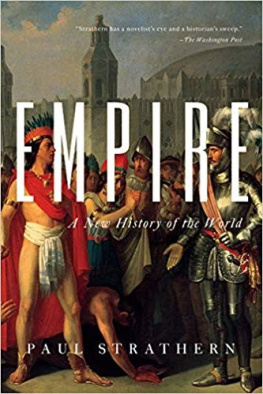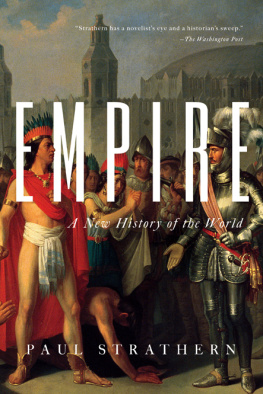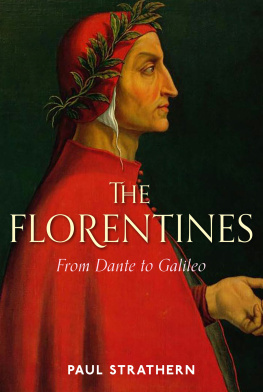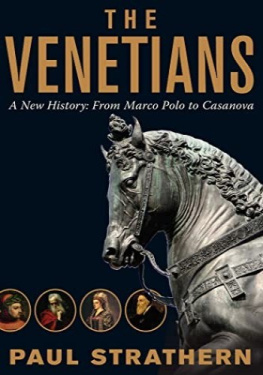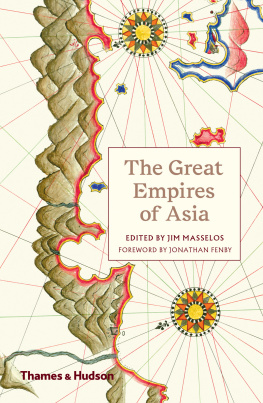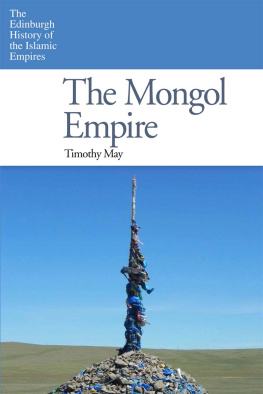EMPIRE
A New History of the World
PAUL STRATHERN
PEGASUS BOOKS
NEW YORK LONDON
To the Kaiser and Lenin
Contents
At the turn of the fifteenth century, China was by some degree the most advanced civilisation on earth. This was the land, tales of whose wonders Marco Polo had earlier brought back to Europe. In 1405, Zhu Di, third emperor of the Ming Dynasty, ordered Admiral Zheng He to set sail from China with his fleet to explore the oceans of the world.
Admiral Zheng He had been in the service of the Emperor Zhu Di since he had been captured as an adolescent, and castrated according to contemporary custom. Zheng He had consequently risen through the ranks to become a man of mighty stature, both politically and physically. Eye-witness reports describe him as being almost seven feet tall and nearly five feet in girth. The fleet he commanded was of even more impressive proportions. It contained over three hundred large ocean-going, wooden-sailed junks manned by more than 28,000 men. The admirals treasure ship, a replica of which can be seen in Nanjing today, was 450 feet long. No comparable fleet would put to sea for over four centuries, until the First World War.
Zheng He and his fleet undertook six voyages between 1405 and 1424, during the course of which he travelled from Vietnam to Indonesia, from Burma, India and Ceylon to the Persian Gulf and up the Red Sea to Jeddah, then around the Horn of Africa down as far south as Kenya. Precise records of these six voyages are no longer extant, but it seems likely that in the course of his travels, Zheng He must have covered a distance equivalent to circumnavigating the globe twice over. Amongst the many wonders that he transported back to China was a giraffe from Somalia. Its arrival in China caused a sensation, confirming the existence of the legendary Chinese qilin , which in the sixth century BC had foretold the arrival of a king without a throne: later taken to be the philosopher Confucius, whose ideas would guide China through two millennia.
In 1430, when Zheng He was in his sixtieth year, he was ordered to undertake a seventh voyage and to proceed all the way to the end of the earth. This voyage would take three years, extend far into legend, and be a voyage from which he would never return. According to the controversial claims of naval historian Gavin Menzies, this voyage took Zheng He around the Cape of Good Hope to West Africa, from whence he crossed the Atlantic to America and rounded Cape Horn, sailing as far north as California. One admiral, who separated from Zheng Hes main fleet, is said to have reached Greenland and returned to China by way of northern Siberia (a passage that is likely to have remained open due to the after-effects of the Medieval Warm Period). Another admiral is said to have sailed as far as Australia, New Zealand and the first drift ice of Antarctica.
Evidence for Gavin Menzies claims are, according to Harvard historian Niall Ferguson, at best circumstantial and at worst non-existent. Despite this, tantalising anomalies appear to remain in the form of Chinese DNA discovered amongst Venezuelan native tribes, a number of medieval Chinese anchors... found off the California coast, as well as some surprisingly prescient coastal features that appeared on maps drawn prior to information received from fifteenth-century European explorers. Confirmation that Menzies amazing claims concerning Zheng Hes legendary seventh expedition were taken seriously in some quarters emerged when the Chinese president Hu Jintao addressed the Australian parliament in 2003, and asserted that the Chinese... had discovered Australia three centuries before Captain Cook.This has now seemingly become official Chinese history.
A modern representation of Admiral Zheng Hes treasure ship, alongside the vessel in which Columbus sailed the Atlantic .
In the years following Admiral Zheng Hes death in India in 1433, new Confucian ministers had risen to power at court, who were hostile to commerce and... to all things foreign. A series of Imperial Haijin Decrees (Sea Bans) were issued, forbidding Chinese ships from sailing to foreign nations. Official records of Zheng Hes voyages were destroyed, and the imperial fleet was confined to port, where it soon fell into disrepair. These decrees were initially proclaimed as a measure against Japanese pirates, but had the unintended consequence of isolating China from the outside world. The progressive outgoing Ming civilisation began to ossify, and one of the greatest eras of orderly government and social stability in human history fell into decline.
Our second telling tale concerning the ethos and legacy of empire happens to take place some three centuries later, just as Chinese isolation was beginning to be disturbed by the arrival of European traders, such as the Portugese, the Dutch and the British. By now, the British were beginning to impose their colonial administration on India. An exemplary instance of this took place in 1770, when the northern province of Bihar was devastated by one of its recurrent famines. Consequently, the de facto ruler of British India, Warren Hastings, ordered the construction of what became known as the Granary of Patna. Captain John Garstin, an engineer in the East India Company Army, was ordered to erect a building for the perpetual prevention of famine in the province.
The result was a highly imaginative edifice, which the locals named the Golghar (the round house). Almost 100 feet tall and nearly 500 feet in circumference at ground level, it dominated the surrounding Indian dwellings, its summit providing views over the city of Patna to the Ganges, sacred river of the Hindus. Its dome-like structure would be recognised by the local population as resembling both a Buddhist stupa and the dome of an Islamic mosque. Ascending around the dome was a spiral staircase, for the use of Indian bearers carrying sacks of grain to be emptied through the hole in the top of the dome, gradually filling the internal hemisphere with sufficient grain to provide for any future famines. The Golghar would be judged to be touched... with the machismo of the imperial presence... the most famous of the practical structures of the Raj.
Captain Garstin ordered an inscription on the side of his architectural masterpiece, which announced that it was First filled and publickly closed by... This proclamation remained forever incomplete. According to the visiting Victorian poet Emily Eden, the Golghar was found to be useless. When I visited Patna, and was shown this celebrated structure, still in good condition almost two centuries after its completion, I was informed of the reason for its redundancy. According to my guide, the door in the base of the dome, through which the grain should have poured out once it was filled, had in fact been constructed so that it only opened inwards.
Some modern sources dispute this significant detail, but when I visited Patna, I could find no one who was not adamant concerning the veracity of this incompetence, and consequent suffering, inflicted by the British. Such views may have been reinforced by the fact that many I spoke to were of sufficient age for the last Bihar famine of 196667 to have been more than a folk memory.
Our third tale of empire brings us into the modern times, when as we shall see many had good reason to believe that this would be the era of humanitys last empires.The worlds two great empires appeared to be hell-bent upon destroying the world itself.
In 1945 the United States Manhattan Project under Robert Oppenheimer was in a race to complete the worlds first atomic bomb. Many of the scientists working under Oppenheimer at the remote Los Alamos site in the New Mexico desert had fled Germany as a result of the Nazi decrees against the Jews, and were referred to ironically as Hitlers Gift to the Western allies. Before Oppenheimer undertook the first bomb test, some of his leading scientists most notably the Hungarian-Jewish Edward Teller raised the possibility that a nuclear explosion might ignite the atmosphere and incinerate all life on earth. Oppenheimer assigned the head of his theoretical physics department, the German-Jewish Hans Bethe, to calculate the likelihood of this taking place.
Next page
